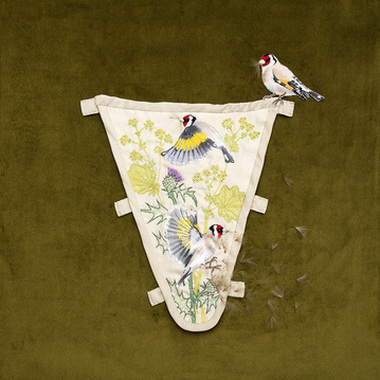 watercolour, and stitch on silk, thistledown The design is based loosely on a beautiful 17th century embroidered stomacher in Emma Dent’s fabulous textile collection, one of my favourite things about Sudeley Castle. The imagery is of goldfinches flying amongst lady’s mantle and milk thistle, scattering thistledown as they feed on the seeds, all things that can be seen in the herb and wildlife gardens. The Stomacher tells a story, not just about Sudeley. It is one of protection, based on tradition, religion, symbolism and ancient herbal knowledge. Lady’s Mantle: In the Victorian Language of Flowers it stands for protection. According to the 17th Century herbalist Culpeper; “Venus claims this herb for her own. Ladies Mantle is very proper for those wounds that have inflammations, and is very effectual to stay bleedings, vomitings and fluxes of all sorts…[and] in all wounds inward and outward …..…which wonderfully drieth up all humidity of the sores, and abates inflammation therein”. In modern herbalism Lady’s Mantle is specifically used for the treatment of excessive menstruation. The Goldfinch: Goldfinches have always been thought of as very special little birds. They are a good luck charm, warding off all contagion, even the plague and bestowing symbolic good health upon anyone who sees one. These birds also had an important symbolic or allegorical meaning. The colour gold was considered to have curative powers and they have gold on their wings According to medieval Christians the splash of red on the face was a bloodstain acquired by the bird when it tried to remove the crown of thorns from Christ’s head at His crucifixion. The favourite food of the goldfinch is thistle seed and their affinity with thistles is another Holy one: the crown of thorns again. So the goldfinch reminds us of Christ’s sacrifice for the salvation of mankind. Milk Thistle: So named because tradition has it that the milk from the Virgin Mary once fell upon the plant and that is why the veins of the leaves are milky white. It was considered to be good for breaking up kidney stones and curing jaundice and according to Culpeper, who calls it by its other name, Lady’s thistle, it had one other very important curative power. “Our Lady’s thistle is under Jupiter and thought to be as effectual as Carduus Beneductus [Holy thistle] for agues, and to prevent and cure the plague.” Modern research has shown that the ripe seeds contain a powerful antioxidant and there is evidence that this may help fight various cancers and help in the treatment of hepatitis and cirrhosis of the liver. You can read about all this in more detail in this article on my blog. Comments are closed.
|